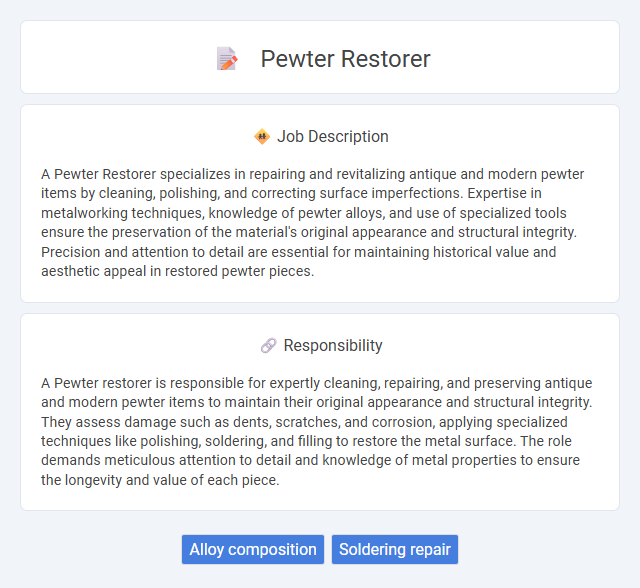
A Pewter Restorer specializes in repairing and revitalizing antique and modern pewter items by cleaning, polishing, and correcting surface imperfections. Expertise in metalworking techniques, knowledge of pewter alloys, and use of specialized tools ensure the preservation of the material's original appearance and structural integrity. Precision and attention to detail are essential for maintaining historical value and aesthetic appeal in restored pewter pieces.
Individuals with strong attention to detail and patience are likely suitable for a pewter restorer job, as it involves delicate and precise work. Those who have manual dexterity and an interest in historical or artistic objects may find this role fulfilling and enjoyable. People prone to frustration with repetitive tasks or lacking fine motor skills might face challenges in this profession.
Qualification
A Pewter restorer must possess in-depth knowledge of metal composition, restoration techniques, and historical styles related to pewter artifacts. Proficiency in using specialized tools such as polishing wheels, ultrasonic cleaners, and chemical solutions is essential for effective restoration and preservation. Strong attention to detail and experience in metallurgy or fine arts provide a significant advantage in accurately restoring and maintaining the integrity of pewter items.
Responsibility
A Pewter restorer is responsible for expertly cleaning, repairing, and preserving antique and modern pewter items to maintain their original appearance and structural integrity. They assess damage such as dents, scratches, and corrosion, applying specialized techniques like polishing, soldering, and filling to restore the metal surface. The role demands meticulous attention to detail and knowledge of metal properties to ensure the longevity and value of each piece.
Benefit
A Pewter restorer likely benefits from preserving historical and artistic value, enhancing the longevity of valuable items. There is a strong probability of gaining specialized skills in metalworking and finishing techniques. This role may offer opportunities for creative expression while contributing to the conservation of cultural heritage.
Challenge
Pewter restorers likely encounter significant challenges in identifying and reversing corrosion and wear without damaging delicate details, which requires expert knowledge and precision. Restoring the original luster and intricate designs of antique pewter could demand advanced techniques and patience. The probability of encountering rare or heavily damaged items may increase the complexity and time required for each restoration project.
Career Advancement
Pewter restorers enhance the appearance and longevity of pewter items by expertly cleaning, repairing, and polishing metal surfaces. Mastery of advanced restoration techniques and material science paves the way for career growth into specialist roles such as conservator or metallurgist. Building a portfolio of high-quality restorations and pursuing certifications can lead to opportunities in museums, auction houses, and luxury antique restoration firms.
Key Terms
Alloy composition
A Pewter restorer specializes in repairing and preserving items made from pewter, an alloy predominantly composed of tin (85-99%), combined with small amounts of copper, antimony, and sometimes lead or bismuth to enhance durability and malleability. Understanding the specific alloy composition is crucial for selecting appropriate restoration techniques, as the variations in the metal's hardness and melting point determine cleaning, soldering, or reshaping methods. Mastery in alloy chemistry ensures that the restored pewter maintains its original sheen, structural integrity, and historic authenticity.
Soldering repair
Pewter restorers specialize in soldering repair techniques to restore damaged or cracked pewter items, ensuring structural integrity and aesthetic appeal. Precision in heating and applying lead-free solder maintains the original design while preventing metal deformation or discoloration. Expertise in flux selection and temperature control is essential for seamless joints and long-lasting repairs in antique and collectible pewter pieces.
 kuljobs.com
kuljobs.com